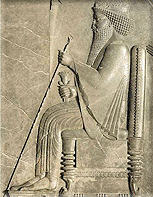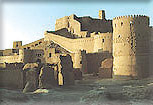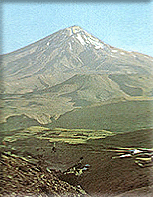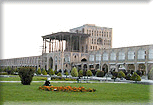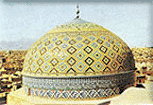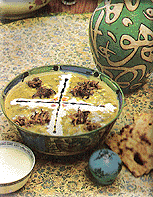|
|
Tehran
The modern
powerhouse of the government and its engineers, Tehran (meaning warm slope) was
originally a village on the suburb of Rey, Iranian capital until Mongol
invasion of the country in 1220 AD, when it population moved to the present
site of Tehran.
Actually, very little is known
of the origin and early history of Tehran. It is possible that it may back to
the ninth century AD, but for the first few hundred years of its existence it
was an insignificant town, its development being retarded by its proximity to
the larger and flourishing Rey (now 7 km to the south of Tehran).
With a different in elevation of
more than 500 meters, and an officially announced population of 8,154,051
(according to 2011 census) in an approximate area of 600 square km, modern
Tehran is situated on the northern fringe of the great central plateau and at
the foot of the southern slope of the impressive mountain chain of Alborz.

Sights to See
-
National Museum of Iran
No visitor can afford to miss the National (Archaeological) Museum of Iran,
the country's mother museum established in 1937 together with a group of
other monumental buildings for various ministries and government
departments. I f make for the Louver on arrival in Paris, this museum is
spiritual home in Tehran, where objects unearthed during recent excavations
are to be found side by side with objects representing the great periods of
history and pre-history.


-
National Jewels Museum
The National Jewels Museum (Crown Jewels before the Revolution) was
organized by virtue of a legal bill passed in 1937. according to
contemporary mineralogists, and gemologists, the treasury of the museum of
Jewel is the richest and most dazzling single collection have never been
able to summon up interest in precious, stones, this collection in the
closely-guarded vaults is a breath taking expires.

Naderi throne-National Jewels Museum

Pahlavi Crown-National Jewels Museum

Darya-e Noor Diamond-National Jewels Museum




-
Sa’d Abad palace-Museum
Known as the Sa’d Abad Cultural complex, It occupies an area of 410
hectares.
Actually, it is the greatest cultural complex in modern Tehran consisting of
seven palace museums (out of 18, turned into public museums after
Revelation).

Sa'd abad Palace gateway

Sa`d abad garden

Green palace - Sa'adabad Palace

The gate of Contemporary art Museum

Saloon No. 4 - Contemporary art Museum

Farmer man & woman - Contemporary art Museum
-
Mellat-Palace-Museum
What is now called the Mellat (Nation's) Palace Museum was previously known
as the White Palace. It was built by Reza Shah to be used as his Imperial
Court. But finding it majestic indeed, he preferred to make it his
residence. Later it was used as both his and his son's Ceremonial Palace.

White House - Sa'd abad Palace

-
Golestan and Other Palaces
The Qajars` royal residence, the oldest substantial building in the city,
and on of a group of royal buildings.
Golestan place (Rose garden), too, was completed by Fath Ali Shah Qajar. The
coronation ceremonies of the last two Kings of the Pahlavi dynasty took
place in the first-floor hall.

Golestan Garden


Golestan Palace - Shams ol Emareh

Marble Throne (Takht-e marmar) Golestan Palace

Peacock Throne (Takht-e Tavoos) - Golestan Palace

Hall of Mirrors (Talar-e ayeneh) - Golestan Palace

Niavaran Palace - Ahmad Shah`s Pavilion

Nice room - saheb gharaniyeh palace
-
Azadi Tower Cultural Complex
The inverted Y-shaped monumental Banay-e Azadi (Azadi Tower) in the vicinity
of Tehran airport, now a symbol of Tehran as the country's capital, and
composed of 25,000 facing stone pieces in 15,000 different shapes, was built
in 1971 in commemoration of the 2,500th anniversary of establishment of the
Iranian Empire.

-
Malek National Museum
Its construction dates back to the late Qajar period. Affiliated to the Holy
Shrine of Imam Reza, its articles on exhibition (precious coins, paintings,
rugs, etc) are housed in a one-story building.

-
13th Aban Museum
This small museum was originally used as municipal stables since the advent
of Pahlavi dynasty. Transformed into museum in 1946 and sponsored by the Red
Crescent organization, it is crammed solid with various watercolor paintings
and bronze figures by the famous modern Iranian sculptor Seyed Ali Akbar-e
San’ati.
All status are life-size or larger and the subjects.

-
Coin Museum
It hoses one of the greatest and most valuable specialized collections of
ancient Iranian coins from pre-Islamic (Achaemenian), Islamic, and
contemporary periods, as well as foreign coins from all over the world
(particularly Phoenician Babylonian, Indian etc).

Coin Museum - Parthian silver coin




-
Tamashagah-e Tarikh
Meaning promenade in the arena of history, this is a quite recent museum
inaugurated in mide-1996 with a display of ancient and highly interesting
variety of artifacts, document, and objects of historic value in a very
attractive atmosphere.


-
Ghazali Cinema Town
Affiliated with the Islamic Republic of Iran Broadcasting Services and
covering an area of 10 hectares, the complex was established in 1971,
partially simulating old Tehran. It comprises various state and historic
buildings, streets, and places of more than 100 years ago decorated by
Iranian decorators, particularly Gianni
Cortina.

UrShalim - Ghazali Cinema Town

Old Tehran`s Street

Old Mercedes Benz - Ghazali Cinema Town
-
Post Museum
This is a very recent museum (established in 1988, to replace another one
which existed since 1954). Affiliated with the Ministry of Post, Telegraph,
and Telephone, the museum is organized in a two-story building plus a
basement.



-
The Wildlife Museum
The Museum of Natural Remains and Wildlife of Iran, Wildlife Museum, is
located in Niavaran, Dar Abad, at the far end of northeast Tehran,
displaying in taxidermy rare species of animals from around the world,
especially southern Africa, in an area of 12,000 square meters of lush green
and forested land, away from the tumult of the city, where you can enjoy the
real tranquility, fresh air, and the grandeur of nature as well.

-
Natural History Museum
Established in 1987, this museum is located on the former premises of the
Environment Preservation Organization. It is arranged in four floors to
display the existing fauna and flora in a chronological order, as follows:
evolution of the earth, plants, and the animal kingdom.

-
Majlis-e Shoray-e Eslami
Formerly Iranian Parliament (Literally meaning the Islamic Consultative
Assembly), holds its meetings in an unusual contemporary style building
located in Imam Khomeini Avenue, erected in 1960.


-
Motahari Mosque and College
Historically known as the Masjid-e Sepah Salar (Mosque of the
Commander-in-Chief), and serving both as a mosque and a theological college,
the Motahari Mosque with its eight minarets set close to each other is the
largest and most important mosque in Tehran (3,700 square meters in area).

Parliment & Sepah Salar Musque

Sepah Salar Musque
-
Reza Abbasi Museum
Housing a valuable collection of arts, paintings, calligraphy and the art of
the book, the Museum consists of two divisions: Pre-Islamic and Islamic
Galleries.

-
Decorative Arts Museum of Iran
It was originally established in 1959, while its official activity commenced
in 1961, the new building housing the collections gathered and donations
made by those interested in the Iranian arts and crafts, comprises four
floors and a basement in which the various items are displayed.

-
Bahman Cultural Center
Located in the southernmost part of Tehran, the Bahman Cultural Center
occupies a vast area. In this cultural center concerts, religious plays
accompanied by hymns, and other rituals are performed.
-
Tehran Metro
The decision to build a metro in Tehran was first made in 1958. However,
upon the victory of the Islamic Revolution in 1979 and withdrawal of the
French contractors, and following the recommendations and emphatic supports
of President, the Metro Company (TMC) was reactivated in 1986.




-
Park-e Ferdowsi
Located in Niavaran district, at the foot of Kolak Chal mountain, The
Ferdowsi Park is the highest park of Tehran and occupies an area about
120,000 sq. m. It was called Park-e Jamshidieh until early March 1997.


-
Park-e Mellat
Located to the north of vanak square, along Vali Asr Avenue, north Tehran,
the Mellat Park with an area of 341,770 sq.m. was originally designed as an
English park and constructed during the 1968-75 period.

-
Park-e Niavaran
Located in northeastern part of Tehran, and called Saheb Qaranieh until
1969, Niavaran Park occupies an area of about 63,000 sq. m. Weather wise, it
is one of the most pleasant parks of Tehran. The plants in the park include
many varied and exotic species, which attract a great number of researchers
in botany.


-
Park-e Shatranj
Located in Ajudanieh Street, Darband Street, North Tehran, it was built in
1991 and covers an area of 3,500 sq. m. literally; the name Park-e Shatranj
means the Chess Park.
Excursions around Tehran
-
Damavand City
Sixty-six km to the east of Tehran, to the right of Tehran-Firuz Kuh road,
Damavand is a small town set in a closed-off and well-watered valley below
the foothills of Mount Damavand whose cone is not visible from this place.

Damavand City

Mount Damavand

Mount Damavand in Spring
-
Karaj Town
A growing town 35 km to the west of Tehran, 1,320 meters above sea level,
with more than 2.5 million inhabitants, and occupying an area of6,000 square
kilo meters, Karaj is situated in the crossroads and starting point of the
road to Chalus over Alborz mountains.

-
Rey City
Closest visit from the capital and some 7 km to the south east of Tehran
along the old national road to Qum, is situated the little bustling, holy,
and modern town of Shahr-e Rey, or just Rey. The plain surrounding the city
is still being irrigated, to some extent, by the ancient Iranian-type of
subterranean canals known as the qanats. According to a 10-century
geographer, it used to be the finest city in the east, discounting Baghdad.
From 5,000 BC to 1200 AD Rey, formerly Raques, or Raga, was a large and
important city.

Rey - Ebn-e Babevaye

Rey - Old Locomotive





-
Harun`s Prison
Locally called Zindan-e Harun, this two-story historical structure 12 km
from the Tehran-Mashhad road at the foot of Mesgar Abad Mountains, consists
of a rectangular construction built with rough-hewn dark-colored stones and
plasters mortar, and has a brick ceiling.

Harun`s Prison

Harun`s Prison-Stepping down from the floor
upwards
-
Varamin Town
Situated in a fertile plain from which the formidable range of Alborz can be
seen in all its glory, famous for its cereals, cotton, melons, and wheat
production, food processing (cooking oil and sugar refineries), and
gradually developing into an industrial town, Varamin is a small town 42 km
to the south of Tehran through Rey.

Iraj Castle of Varamin

Varamin mosque - medieval period

Inscription inside Varamin mosque
|
|












































































